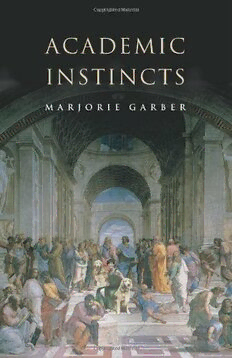
Academic instincts PDF
Preview Academic instincts
Copyright©2001byMarjorieGarber PublishedbyPrincetonUniversityPress,41WilliamStreet, Princeton,NewJersey IntheUnitedKingdom:PrincetonUniversityPress, 3MarketPlace,Woodstock,OxfordshireOX201SY ErichLessing/ArtResource,NY ReprintedwiththepermissionofSimon&SchusterBooksfor YoungReaders,animprintofSimon&SchusterChildren’s PublishingDivision,fromAliceinWonderlandbyLewisCarroll, illustratedbySirJohnTenniell(Macmillan,NY,1963) ©TheNewYorkerCollection2000RozChastfromcartoonbank.com. AllRightsReserved. Copyright,1999,Danziger.Distributedbythe LosAngelesTimesSyndicate.Reprintedwithpermission. ALLRIGHTSRESERVED LibraryofCongressCataloging-in-PublicationData Garber,MarjorieB. AcademicInstincts/MarjorieGarber. p. cm. Includesbibliographicalreferencesandindex. ISBN0-691-04970-X 1.Humanities—StudyandTeaching(Higher)2.Literature— Studyandteaching(Higher)3.Universitiesandcolleges—Curricula. 4.Academicwriting.5.Humanities—Philosophy.6.Learning andscholarship.I.Title. AZ182.G372001 001.3′071′1—dc21 00-056510 ThisbookhasbeencomposedinNewBaskervilleTypeface Thepaperusedinthispublicationmeetstheminimumrequirements ofANSI/NISOZ39.48-1992(R1997)(PermanenceofPaper) www.pup.princeton.edu PrintedintheUnitedStatesofAmerica 1 3 5 7 9 10 8 6 4 2 For my graduate students, past and present This page intentionally left blank CONTENTS Preface · ix 1 HE MATEUR ROFESSIONAL AND THE T A P ROFESSIONAL MATEUR 3 P A · 2 ISCIPLINE NVY 53 D E · 3 ERMS OF RT 97 T A · 149 Notes · 181 Index · This page intentionally left blank PREFACE NCOMBINING I themost“disciplined” andthemost“undisci- plined”offorces,thetitleAcademicInstinctsismeanttosound like a contradiction in terms. But this is a book about the energiesthatkeepscholarlydisciplinesfrombecominginert and settled. It is about the instincts not of individuals but of fields—what might be called the disciplinary libido. In each chapter, I consider the ways in which a field differentiates itself from, but also desires to become, its nearest neighbor, whetherattheedgesoftheacademy(theprofessionalwants to be an amateur and vice versa), among the disciplines (eachonecovetsitsneighbor’sinsights),orwithinthedisci- plines (each one attempts to create a new language specific to its objects, but longs for a universal language understood by all). The chapters that follow thus address the current world of scholarship in the humanities in three different modes:throughpersons(“TheAmateurProfessionalandthe ProfessionalAmateur”),institutions(“DisciplineEnvy”),and language (“Terms of Art”). I suggest that various attacks against the academic profes- sion and various feuds within it—the disparagement of amateursbyprofessionalsandprofessionalsbyamateurs,the desire to keep the disciplines pure, the accusation that aca- demic writing is, unlike the language of the real world, jar- x PREFACE gon-riddenandincomprehensible—needtobereconceived. My fundamental argument has two strands. One is to show thatthesefeudsarenotstable.“Amateur,”forexample,func- tions as a term of praise during one period or if it comes from one direction, and as a term of abuse during another orifitspringsfromadifferentsource.Whatistakentocon- taminate different disciplines varies as the prestige (and in- tellectual accomplishments) of other disciplines change. Terms that are “jargon” today will be everyday language to- morrow. The other strand of my argument is to show that many of the contrasts around which these disputes revolve do not signify real opposites, but rather depend upon one another for their strength and effectiveness. In each case, I willmaintainthatthetermsofpraiseorabusehaveadouble nature, and that it is important to acknowledge that dou- bleness. The doubleness, in other words, is in many ways moreimportantthanthepositiveornegativejudgmentsthe termsconveyatanyonetime.Thepointisnottochoosethe right inflection for each term but to show how intellectual life arises out of their changing relationship to each other. Ishouldsaysomethinghereaboutwhatthisbookisnot.It is not a developmental history of the disciplines or of the professionofteachingEnglishorthehumanities.Thatwork has been powerfully and effectively undertaken by scholars likeGeraldGraff,JohnGuilloryandW.BlissCarnochan.This bookisnotthestoryoftheencounterofthehumanitieswith the world of science and social science, the world of “fact.” Thatkindofwork,too,hasbeenwelldone,byPeterGalison and Mary Poovey among others. And this book is not the latestsalvointheso-called“culturewars,”aformulationthat PREFACE xi was always more hype or buzz than pedagogical reality. I ad- dress these questions not to take a side in the polemic, nor to position myself above it, but to explore the ways in which thesecontroversiesareessentialto thenatureofintellectual life. The things deplored or defended in discussions of the humanities cannot be either eliminated or endorsed, be- cause the discussion itself is what gives humanistic thought its vitality. Scholars, despite what their critics say or what they them- selves may claim, are basically conservative creatures (in the widest sense of that misused term), whose engagement with ideas and with students has been very much the same since the time ofthose renegade pedagogues, Platoand Aristotle. Despite the presence of Diogenes and of two delighted golden retrievers on the cover, there are no cynics in these pages, and relatively few, all things considered, in academic life. Teaching and writing at a college or university is a job for optimists and for idealists, whatever discursive or critical mode we may use in trying to shape ideas and the world. So this book is not a history. It is an analysis, an interven- tion, and a credo. Although in the pages below I will make some pointed observations about the evocation of “love” in the teaching of the humanities, it would be fair to call this a love letter. A letter, sometimes critical, sometimes affection- ate,always—Ihope—passionate,addressedtoalifelongpart- ner and companion, the profession of literary study. This page intentionally left blank
